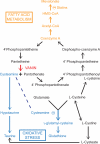Diverse biological activities of the vascular non-inflammatory molecules - the Vanin pantetheinases
- PMID: 22155241
- PMCID: PMC3259148
- DOI: 10.1016/j.bbrc.2011.11.099
Diverse biological activities of the vascular non-inflammatory molecules - the Vanin pantetheinases
Erratum in
- Biochem Biophys Res Commun. 2012 Jun 15;422(4):786. Michael Proffit, J [corrected to Proffitt, J Michael]
Abstract
The Vanin genes are a family that encode pantetheinases involved in recycling Coenzyme A, catalysing the breakdown of intermediate pantetheine to vitamin B5 for reuse in CoA biosynthesis. The role of pantetheinase in this most fundamental of cellular processes, was substantially characterised by the 1970s. The next 20 years saw little further interest in pantetheinase until various genetic studies implicated the Vanin locus in a range of normal and disease phenotypes, and a consequent interest in the other product of pantetheinase activity, cysteamine. This report seeks to bring together the early biochemical studies with recent biological data implicating cysteamine as a regulator of the oxidative state of a cell. Numerous studies now report a role for Vanin in inflammation, oxidative stress, cell migration and numerous diseases including cardiovascular disease.
Copyright © 2011 Elsevier Inc. All rights reserved.
Figures



References
-
- Martin F, Malergue F, Pitari G, et al. Vanin genes are clustered (human 6q22-24 and mouse 10A2B1) and encode isoforms of pantetheinase ectoenzymes. Immunogenetics. 2001;53:296–306. - PubMed
-
- Galland F, Malergue F, Bazin H, et al. Two human genes related to murine Vanin-1 are located on the long arm of human chromosome 6. Genomics. 1998;53:203–213. - PubMed
-
- Aurrand-Lions M, Galland F, Bazin H, et al. Vanin-1, a novel GPI-linked perivascular molecule involved in thymus homing. Immunity. 1996;5:391–405. - PubMed
-
- Maras B, Barra D, Dupre S, et al. Is pantetheinase the actual identity of mouse and human vanin-1 proteins? Journal of Clinical Investigation. 1999;113:149–152. - PubMed
-
- Pitari G, Malergue F, Martin F, et al. Pantetheinase activity of membrane-bound Vanin-1: lack of free cysteamine in tissues of Vanin-1 deficient mice. Febs Letters. 2000;483:149–154. - PubMed
Publication types
MeSH terms
Substances
Grants and funding
LinkOut - more resources
Full Text Sources
Other Literature Sources
Molecular Biology Databases

